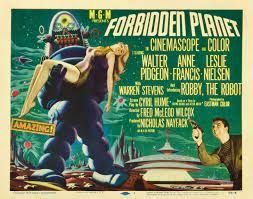Forbidden Planet: the Star Wars of the 1950s (but with more Shakespeare and less Lightsabers).
Forbidden Planet. If the name doesn’t ring a bell, then clearly, you’re missing out on one of the most seminal pieces of science fiction cinema. Picture this: it’s 1956, Elvis Presley is crooning his way into the hearts of millions, and amidst all the rock ‘n’ roll frenzy, MGM releases what can only be described as the Star Wars of its time. Yes, before Luke Skywalker ever wielded a lightsaber, Leslie Nielsen was busy combating “monsters from the id” on a distant planet named Altair IV.
Shakespeare in Space?
First off, let’s clear one thing up: Forbidden Planet isn’t just any old sci-fi flick. It’s essentially Shakespeare’s The Tempest, but with more futuristic gizmos and fewer enchanted islands. Instead of Prospero, we get Dr. Edward Morbius, a brainy recluse with a killer robot sidekick named Robby. And instead of Ariel, we have… well, still a bunch of airy nothingness, but that nothingness is a terrifying invisible monster. Morbius, played by Walter Pidgeon, isn’t summoning spirits; he’s dabbling with the remnants of an ancient, uber-intelligent race known as the Krell. Talk about taking a classic to the next level.
Groundbreaking Special Effects (That Won’t Scare You Now)
The special effects in Forbidden Planet were groundbreaking for their time. The invisible “Id Monster” was created using the animation skills of Disney’s Joshua Meador. Back then, it was terrifying enough to warrant some scenes being cut for younger audiences. Today? Well, let’s just say modern viewers might find it charmingly quaint rather than spine-chilling. But credit where credit is due: the effects team was nominated for an Academy Award, a rare feat for sci-fi films in those days. And let’s not forget Robby the Robot, who was so advanced (and expensive) that he nearly outshone the human cast.
The Electronic Tonalities of Bebe and Louis Barron
One of the film’s most significant contributions was its soundtrack. Composed by Bebe and Louis Barron, it was the first entirely electronic score for a film. Back then, this was a big deal. Imagine listening to a symphony of bleeps, bloops, and ominous hums, which was as futuristic as it could get in 1956. Today, it might sound like your old dial-up modem trying to connect to the internet, but hey, it was revolutionary.
Plot Twists and Moral Lessons
The plot revolves around Commander John J. Adams (Leslie Nielsen, long before he became the king of deadpan comedy) and his crew landing on Altair IV. There, they encounter Dr. Morbius, his daughter Altaira, and the remnants of a lost civilization. The Krell, with their mind-bending technology, serve as a cautionary tale about the dangers of unchecked intellectual advancement. They built machines that could materialize anything they imagined, but forgot one tiny detail: their own subconscious monsters. The result? Extinction.
Moral of the story: even in space, you can’t escape your inner demons. Adams eventually convinces Morbius that his subconscious mind has been unleashing chaos, but it takes the scientist a fatal confrontation with his own creation to accept the truth. And just like that, the planet’s self-destruct button is pressed, leading to a spectacular finale that leaves you pondering the hubris of humanity.
Cultural Impact and Legacy
Forbidden Planet’s legacy extends beyond the silver screen. It inspired a bookshop named after it and influenced countless sci-fi narratives, including Star Trek. Even the visual effects and design aesthetics found echoes in series like Babylon 5 and films like Serenity. And let’s not overlook the pop culture references: from The Rocky Horror Picture Show to Doctor Who, the film’s impact is ubiquitous.
In the grand scheme of sci-fi history, Forbidden Planet stands tall as a precursor to the space operas and techno-thrillers that followed. It’s a film that dared to dream big, combining Shakespearean drama with mid-20th century futurism. If you haven’t seen it, grab some popcorn, dim the lights, and prepare for a retro journey into the far reaches of the galaxy. Just don’t expect any epic space battles or Jedi mind tricks. Instead, revel in the charm of a time when a film could captivate with the power of imagination and a robot that could whip up a whisky faster than you can say “Robby the Robot”.
So here’s to Forbidden Planet: the original space odyssey that’s part Shakespeare, part sci-fi, and all classic.



